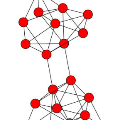Temporal networks are an important type of network whose topological structure changes over time. Compared with methods on static networks, temporal network embedding (TNE) methods are facing three challenges: 1) it cannot describe the temporal dependence across network snapshots; 2) the node embedding in the latent space fails to indicate changes in the network topology; and 3) it cannot avoid a lot of redundant computation via parameter inheritance on a series of snapshots. To this end, we propose a novel temporal network embedding method named Dynamic Cluster Structure Constraint model (DyCSC), whose core idea is to capture the evolution of temporal networks by imposing a temporal constraint on the tendency of the nodes in the network to a given number of clusters. It not only generates low-dimensional embedding vectors for nodes but also preserves the dynamic nonlinear features of temporal networks. Experimental results on multiple realworld datasets have demonstrated the superiority of DyCSC for temporal graph embedding, as it consistently outperforms competing methods by significant margins in multiple temporal link prediction tasks. Moreover, the ablation study further validates the effectiveness of the proposed temporal constraint.
翻译:时间网络是一个重要的网络类型,其表层结构随时间变化。与静态网络的方法相比,时间网络嵌入(TNE)方法面临三个挑战:(1) 它无法描述网络快照之间的时间依赖性;(2) 潜伏空间的节点嵌入未能显示网络地形的变化;(3) 它无法避免通过一系列快照的参数继承进行大量重复计算。 为此,我们提议了一个新的时间网络嵌入方法,名为动态集群结构控制模型(DyCSC),其核心思想是通过对网络节点对特定数个集群的趋势施加时间限制来捕捉时间网络的演变。它不仅为节点生成低维嵌载矢量,而且还保护了时间网络的动态非线性特征。多个真实世界数据集的实验结果证明了DyCSC对于时间图形嵌入的优势,因为它始终超越了多个时间链接预测任务中的重要边际的竞合方法。此外,通缩研究还进一步验证了拟议的时间约束的有效性。





